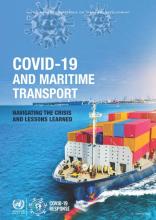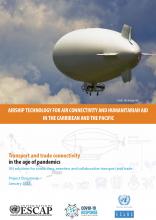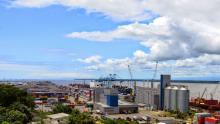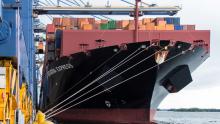
BUILDING CAPACITY TO MANAGE RISKS AND ENHANCE RESILIENCE A Guidebook for Ports
The guidebook presents a step-by-step approach to resilience building in the maritime supply chain. It sets out risk identification, assessment and management tools and techniques, and describes a resilience-building process for ports.
The guidebook emphasizes lessons learned and good practices and highlights relevant measures that can be implemented to prepare, respond and recover from disruptions.

Resilient Maritime Logistics Website
The Resilient Maritime Logistics website (https://resilientmaritimelogistics.unctad.org) hosts a guidebook for ports aiming at Building Capacity to Manage Risks and Enhance Resilience. It features risk identification, assessment, and management tools and approaches, case studies, good practices and a step-by-step resilience-building process for ports and other relevant maritime supply chain actors. The guidance focuses on three types of resilience-building actions and measures, namely:
- Before a disruption materializes.
- During a disruption.
- After a disruption.
A course structured around six modules and focusing on Port and Maritime Supply Chain Resilience accompanies the guidance on this website. The training will help to better understand the importance of well-functioning maritime supply chains and ports for highly interdependent world economies and the need to build their resilience in the face of heightened, uncertainty and disruptions.
The Resilient Maritime Logistics website and related content and material aim to help stakeholders across the maritime supply chain to better manage risks, prepare in the face of disruptions, ensure effective response measures and enable rapid recovery. Targeted stakeholders include (i) governmental planning and regulatory agencies; (ii) port authorities; (iii) port operators and port management companies; (iv) terminal operators; (v) infrastructure managers; (vi) freight forwarders; (vii) customs authorities; (viii) carriers and shipping companies; (ix) shippers and cargo owners; and (x) inland carriers and inland logistics operators (e.g. dry ports, inland container depots, warehouses, logistics and distribution centres). Collaboration between each of these stakeholders is critical for maritime supply chain agility and resilience-building.

COVID-19 and Maritime Trasport: Navigating the Crisis and Lessons Learned
UNCTAD's report "Covid-19 and maritime transport: Navigating the crisis and lessons learned" describes how the COVID-19 pandemic shocked the global maritime transport system and some of the key effects on the sector. It highlights challenges arising from the disruption across ports and hinterland connections and examines response and mitigation measures implemented by various stakeholders. It sets out the key lessons that can inform and guide preparedness and resilience-building efforts in transport and logistics.

Airship Technology for Air Connectivity and Humanitarian and the Caribbean and the Pacific
The Airship transport alternative, in its diverse engineering variants, has the potential to be a game-changing technology with significant development in recent years. It offers the technical capabilities to make a broad contribution to the optimization of mobility and logistics networks in isolated communities and territories, especially but not only in Small Island Developing States (SIDS). This is particularly important in the context of the ongoing COVID-19 pandemic, as in the event of a disaster, different aid agencies are deployed with support in the distribution and logistics of perishable and essential cargo, equipment, and assistance personnel. This innovative mode should be incorporated into the transport matrix (both nationally and regionally), for the latter to move towards more efficient, sustainable, and resilient networks.

COVID-19 and maritime transport: Disruption and resilience in Africa
Impacts of the COVID-19 disruption on maritime trade flows, port calls, and liner shipping connectivity in Africa.
COVID-19 and maritime transport: Impacts and Responses
The report sets out the UNCTAD assessment of the COVID-19 impacts on the maritime supply chain and challenges faced. It also identifies response measures introduced by relevant stakeholders, and the lessons learned in terms of resilience-building and implications for the maritime supply chain of the future.

COVID-19 and maritime transport: Disruption and resilience in Asia
Impacts of The presentation sets out the impact of the COVID-19 disruption on maritime trade flows, port calls, and liner shipping connectivity in Asia. It also considers the response measures and coping strategies adopted in the face of the disruptive pandemic, and the lessons learned and good practices relating to the maritime supply chain resilience-building.the COVID-19 disruption on maritime trade flows, port calls, and liner shipping connectivity in Asia
Impact of COVID-19 on transport and logistics connectivity in the Caribbean
Given their small size and geographic isolation, Caribbean countries are highly reliant on trade and tourism as important sources of income and employment. Lockdowns in the wake of the COVID-19 pandemic have left islands closed, airports without flights, hotels shuttered, cruise ships docked in ports and economies in crisis.
This research provides a detailed explanation of the responses to COVID-19 in the areas of international trade and transport adopted by English-speaking countries of the Caribbean Community (CARICOM) to limit the effects of the pandemic on trade operations and supply chains in the region. It also provides a set of policy recommendations to preserve and improve trade and transport connectivity in the Caribbean basin.

COVID-19 and maritime transport: Disruption and resilience in Latin America and the Caribbean
Impacts of the COVID-19 disruption on maritime trade flows, port calls, and liner shipping connectivity in Latin America and the Caribbean.